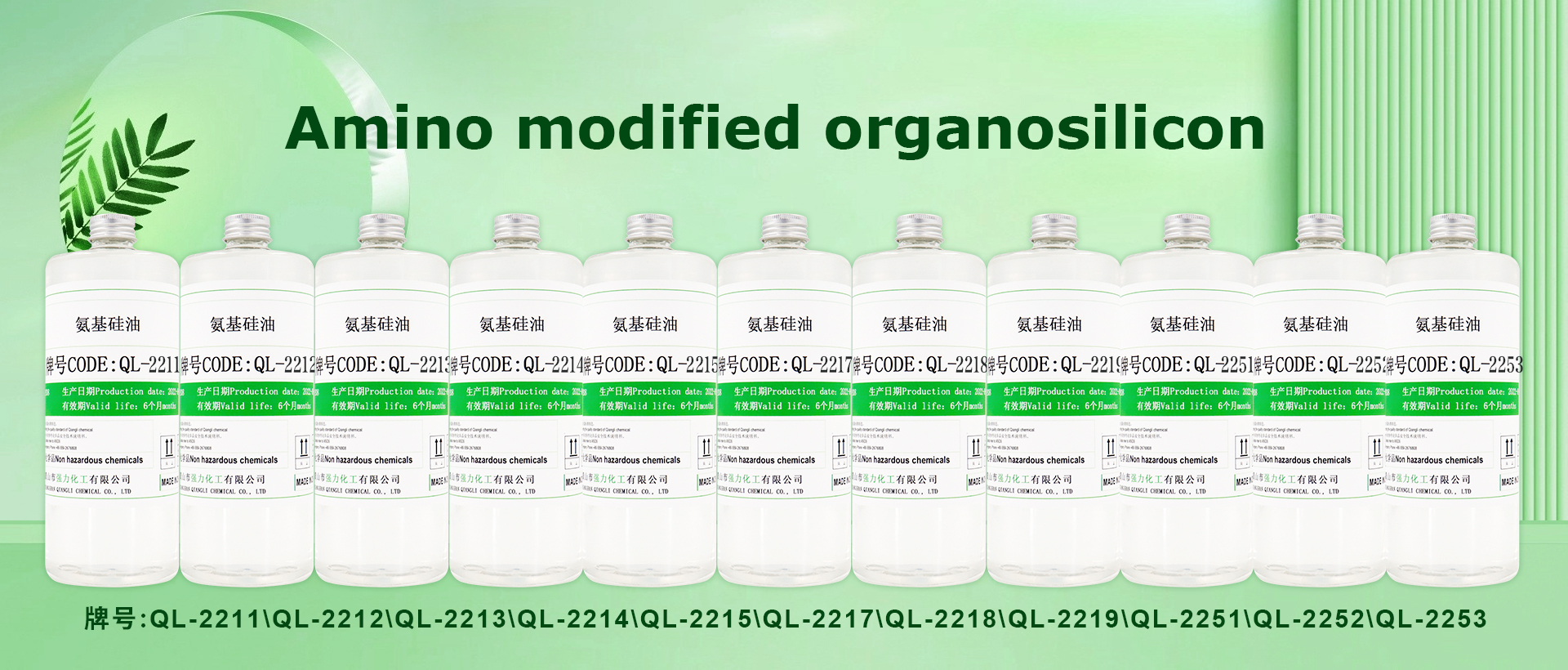
What are the characteristics of amino silicone oil?
Amino silicone oil has three important parameters: ammonia value, viscosity, and reactivity. They are usually used to characterize the molecular structure of amino silicone oil. These three characteristic parameters basically reflect the quality of amino silicone oil and affect the finishing effect of the fabric. The performance of the finished fabric depends on: the size of the ammonia value, whether the amino group is evenly distributed, and the molecular weight of the amino silicone oil.The ammonia value is a characterization of the amino content, that is, the amount of hydrochloric acid with a concentration of 1 mol/L consumed to neutralize 1g of amino silicone oil, in units of mmol/g. Therefore, the ammonia value is directly proportional to the molar percentage of the amino content in the silicone oil. The soft and smooth effect of amino silicone oil on the fiber is largely related to the amount of amino content in the molecule. The higher the amino content, the greater the ammonia value, and the softer and smoother the feel of the finished fabric. However, the properties of the fabric do not entirely depend on the ammonia value. Whether the amino group is evenly distributed and the molecular weight of the amino silicone oil will affect the properties of the fabric. The ammonia value of amino silicone oil used as a fabric finishing agent is generally between 0.2 and 0.6.
Ammonia equivalent is also often used to indicate the amino content, which refers to the molar mass equivalent to one N atom in the amino-modified silicone oil molecule (ammonia equivalent = amino-modified silicone oil molar mass/number of N atoms in the molecule). Therefore, the larger the ammonia equivalent, the fewer amino groups the corresponding silicone oil contains.
In addition, the amino content can also be characterized by the amino molar mass fraction.
Viscosity is an appearance representation of the molar mass of amino silicone oil. The molecular weight of amino silicone oil can be determined by osmotic pressure (VPO) or gel permeation chromatography (GPC), but due to instrument limitations, viscosity is more commonly used to characterize it. The viscosity of amino silicone oil is directly proportional to the molecular weight. The greater the viscosity, the greater the molecular weight. Since amino silicone oil molecules will cross-link when the fabric is dried and fixed, the initial molecular weight of amino silicone oil will be different from the molecular weight that will eventually form a film on the fabric.
Reactivity refers to the property that silicone oil can react chemically with the matrix under fabric finishing conditions, which refers to the end groups and substituents of amino silicone oil molecules. These groups can be methyl groups or reactive methoxy groups or hydroxyl groups. When treating fabrics, amino silicone oil with reactive end groups can crosslink on the fiber surface or react chemically with groups such as hydroxyl groups on the fiber. Therefore, if a suitable crosslinking agent is selected, the fabric can be made softer, smoother and more elastic.
There are many reports on the relationship between the molecular structure of silicone oil and its softening effect.

What are the applications of amino silicone oil?
The textile chemical fiber application properties of aminosilicone oil are as follows:
(1) Good softness and performance. Amino silicone oil is a cationic silicone oil. Its biggest feature is its good softness. If the softness level is divided into 11 levels from 0 to 10, then the softness level of fabrics treated with amino silicone oil is ≥7;
(2) Reduce the friction coefficient of the fabric surface and give the fabric a smooth feel. Someone in Japan used amino silicone oil with a viscosity of 800mm2/s and an ammonia equivalent of 2000 to treat polyester corrugated fabric. The static friction coefficient of the fabric surface dropped significantly, from 0.267 to 0.107;
The textile chemical fiber application properties of aminosilicone oil are as follows:
(3) Improve the tear resistance and resilience of fabrics. Because amino silicone oil can cross-link on the surface of the fabric to form a membrane with a network structure, thereby enhancing the tear resistance and resilience of the fabric;
(4) It can give the fabric some special feel. This is especially obvious in the finishing of blended fabrics. For example, on polyester/cotton fiber fabrics, high-viscosity amino silicone oil can give the fiber a plump, cotton-like feel, while low-viscosity amino silicone oil can give the fiber a smooth silky feel;
The textile chemical fiber application properties of aminosilicone oil are as follows:
(5) The fabric has good washing resistance. Since the amino group reacts with the reactive groups on the surface of the fabric, it is firmly adsorbed on the surface of the fabric, thus making the fabric have good wash resistance;
(6) To impart antistatic properties to fabrics, cationic polyether modified amino silicone oil has the best effect.
Release agent:
Amino silicone oil has good lubricity and anti-sticking properties, is non-toxic, high temperature resistant and non-volatile, non-corrosive to metals, and is not miscible with most rubbers and plastics. At the same time, it has good sprayability and makes demoulding parts easier. The surface has good smoothness. It can also play a stabilizing role in the release agent and prevent the release agent from delaminating, so it is an ideal release agent.
Polish:
Amino silicone oil, whether in liquid or emulsion form, can be cross-linked and solidified, and is suitable for metal, car polishing and soft surface decoration. In addition, amino silicone oil can continue to cross-link and form chemical bonds with the surface, which can improve the durability of the polishing film. Durability and water resistance, if polished with wax, the gloss will only remain for 1 week, while with polishes containing amino silicone oil, the gloss can be maintained for 2 to 3 months.
Resin modifier:
The three functional materials of polyurethane, epoxy resin and acrylic resin have been widely used due to their excellent physical and mechanical properties. But at the same time, they also have many shortcomings. For example, polyurethane is not resistant to high and low temperatures and is easy to age; epoxy resin has high surface energy, is brittle, and has poor impact resistance and cracking resistance; acrylic resin is extremely sensitive to temperature, that is, "hot sticky and cold brittle" , and are not resistant to organic solvents and other shortcomings, which limits their application in certain specific fields. If they are modified with amino silicone oil, their shortcomings can be effectively improved. Research has found that the introduction of aminopolysiloxane can reduce the modulus of epoxy resin to a certain extent, increase its flexibility, and significantly improve its surface properties.
Personal care product additives:
Amino silicone oil is an important additive in cosmetics. Based on its strong adsorption and good smoothness, amino silicone oil has been widely used in shampoos, perms, hair repair agents and hair fixatives. Adding a small amount of amino silicone oil to shampoo can make water, surfactants and other ingredients easy to disperse, and can effectively reduce the friction coefficient between hair and between hair and comb, thereby making the hair easy to comb and giving it softness and softness. Smooth feel; adding a small amount of amino silicone oil to toothpaste can form a stable hydrophobic film on the tooth surface, effectively preventing tooth staining caused by smoking and drinking tea, and also preventing dental caries caused by bacteria or organic acids. Helps maintain oral hygiene.
Paper softener, leather slipper:
Amino silicone oil can be used as a paper softener and leather slip agent. Its mechanism of action is roughly the same as its mechanism as a fabric softener. Compared with other paper softeners, cationic amino silicone softeners have a super soft effect on paper, but the whiteness, strength and hygroscopicity of the paper after finishing are reduced. If an appropriate amount of polyether modified silicone oil, reinforcing agent and amino silicone oil are used for compounding, and then used for finishing, the above shortcomings can be effectively improved. Amino silicone oil is used as a leather slip agent, which can make the leather have good physical and mechanical properties as well as good slipperiness, breathability, hydrophobicity and resistance to dry and wet rubbing.
Paint additives:
Adding amino silicone oil into the coating can effectively improve the dispersion of pigments and fillers in the coating, improve the appearance and color uniformity of the coating, as well as the gloss and bright color after curing. It can also reduce or prevent coating of adhesions. In addition, water-based emulsion coatings containing amino silicone oils can withstand multiple freeze-thaw cycles without breaking the emulsion.




